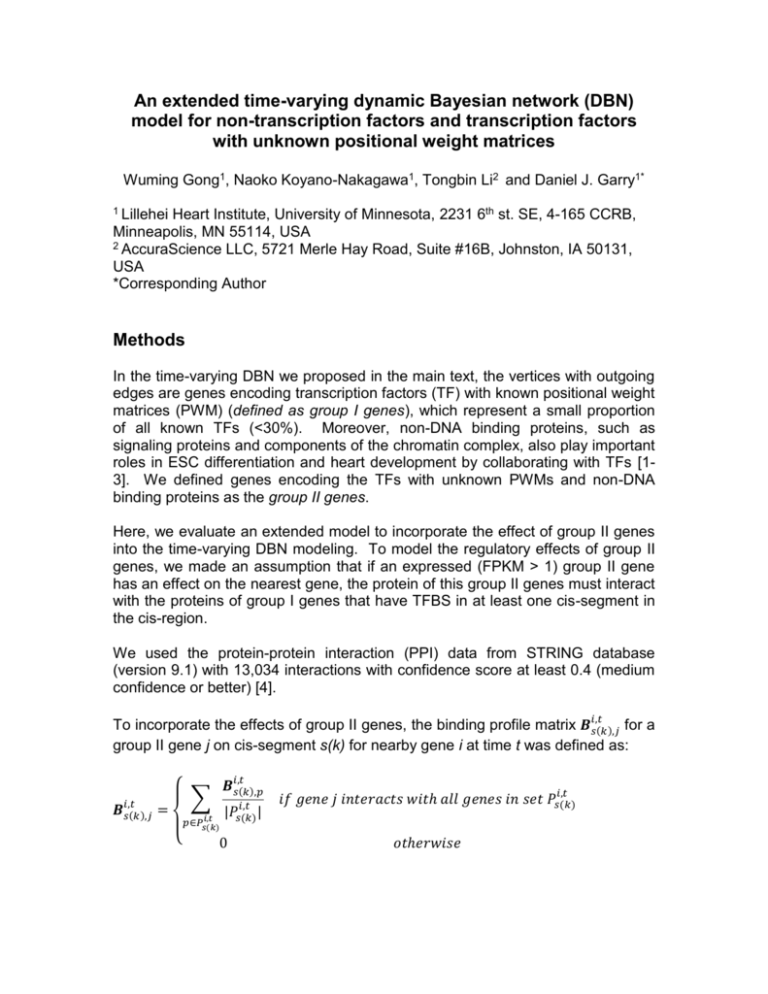file - BioMed Central
advertisement

An extended time-varying dynamic Bayesian network (DBN)
model for non-transcription factors and transcription factors
with unknown positional weight matrices
Wuming Gong1, Naoko Koyano-Nakagawa1, Tongbin Li2 and Daniel J. Garry1*
1 Lillehei
Heart Institute, University of Minnesota, 2231 6th st. SE, 4-165 CCRB,
Minneapolis, MN 55114, USA
2 AccuraScience LLC, 5721 Merle Hay Road, Suite #16B, Johnston, IA 50131,
USA
*Corresponding Author
Methods
In the time-varying DBN we proposed in the main text, the vertices with outgoing
edges are genes encoding transcription factors (TF) with known positional weight
matrices (PWM) (defined as group I genes), which represent a small proportion
of all known TFs (<30%). Moreover, non-DNA binding proteins, such as
signaling proteins and components of the chromatin complex, also play important
roles in ESC differentiation and heart development by collaborating with TFs [13]. We defined genes encoding the TFs with unknown PWMs and non-DNA
binding proteins as the group II genes.
Here, we evaluate an extended model to incorporate the effect of group II genes
into the time-varying DBN modeling. To model the regulatory effects of group II
genes, we made an assumption that if an expressed (FPKM > 1) group II gene
has an effect on the nearest gene, the protein of this group II genes must interact
with the proteins of group I genes that have TFBS in at least one cis-segment in
the cis-region.
We used the protein-protein interaction (PPI) data from STRING database
(version 9.1) with 13,034 interactions with confidence score at least 0.4 (medium
confidence or better) [4].
To incorporate the effects of group II genes, the binding profile matrix 𝑩𝑖,𝑡
𝑠(𝑘),𝑗 for a
group II gene j on cis-segment s(k) for nearby gene i at time t was defined as:
𝑩𝑖,𝑡
𝑠(𝑘),𝑗
𝑩𝑖,𝑡
𝑠(𝑘),𝑝
∑
=
𝑖,𝑡
𝑝∈𝑃𝑠(𝑘)
{
𝑖,𝑡
|𝑃𝑠(𝑘)
|
0
𝑖,𝑡
𝑖𝑓 𝑔𝑒𝑛𝑒 𝑗 𝑖𝑛𝑡𝑒𝑟𝑎𝑐𝑡𝑠 𝑤𝑖𝑡ℎ 𝑎𝑙𝑙 𝑔𝑒𝑛𝑒𝑠 𝑖𝑛 𝑠𝑒𝑡 𝑃𝑠(𝑘)
𝑜𝑡ℎ𝑒𝑟𝑤𝑖𝑠𝑒
𝑖,𝑡
where 𝑃𝑠(𝑘)
is a set of group I genes, whose binding profile is non-zero on cissegment s(k) for nearby gene i at time t. In other words, if a group II gene j
interacts with all group I genes that bind to a cis-segment of nearby gene i, the
effect of gene j on nearby gene i is the mean effects of this set of group I genes.
By extending the model in this way, we incorporated the effects of group II
genes, that is, non-TF genes or TF genes without known PWMs, into timevarying DBN.
Results
By using this extended model, we predicted 40,810, 7,814 and 2,335 additional
gene-gene edges that involved 97 additional group II genes (Supplementary
Figure 7A) in ESC-MES, MES-CP and CP-CM transitions, respectively. Among
these group II genes, 37 genes were annotated with sequence-specific DNA
binding transcription factor activity (GO:0003700) in Gene Ontology [5]. There
were 64, 45 and 43 group II genes with outgoing edges in ESC-MES, MES-CP
and CP-CM transitions, respectively (Supplementary Figure 7B). The most
linked group II genes included Ep300, SWI/SNF complex members Actl6a,
Smarca4, Mta2, Arid1b and Sall1, as well as histone deacetylase 1/2 (Hdac1 and
Hdac2). It has been shown that SWI/SNF complex is required for pluripotency of
mouse ESC, and deficiency of SWI/SNP components impaired the ability of
mouse ESC to differentiate into three germ layers[3]. SWI/SNF complex is also
required for cardiogenesis and regulates the function of key cardiac factors such
as Nkx2-5 and Mef2c [1, 2].
The functional analysis of group II genes in three transitions suggested that
mouse phenotypes such as abnormal heart morphology (MP:0000266),
abnormal myocardium layer morphology (MP:0004056) and abnormal cardiac
muscle tissue morphology (MP:0010630) are significantly enriched in 43 group II
genes in the CP-CM transition (FDR < 1E-3) but not in the genes in ESC-MES
transition [6]. The predicted sub-network that included 57 group I genes and 43
group II genes in the CP-CM transition are shown in Supplementary Figure 7C.
In summary, we provided an extension of our original model with the capability of
incorporating the effects of group II genes into the time-varying DBN modeling.
The results suggested that this extended model successfully predicted the
additional gene regulatory pathways (such as SWI/SNF complex) that are
important for heart development. However, this extended model relies on the
quality of the PPI data, which are still largely incomplete and static. We believe
that, although demonstrated to be feasible, further improvement of the modeling
process awaits dynamic and more accurate PPI data.
References
1. Lei I, Gao X, Sham MH, Wang Z: SWI/SNF protein component BAF250a
regulates cardiac progenitor cell differentiation by modulating chromatin
accessibility during second heart field development. Journal of Biological
Chemistry 2012, 287:24255–24262.
2. Lickert H, Takeuchi JK, Both Von I, Walls JR, McAuliffe F, Adamson SL,
Henkelman RM, Wrana JL, Rossant J, Bruneau BG: Baf60c is essential for
function of BAF chromatin remodelling complexes in heart development.
Nature 2004, 432:107–112.
3. Yan Z, Wang Z, Sharova L, Sharov AA, Ling C, Piao Y, Aiba K, Matoba R,
Wang W, Ko MSH: BAF250B-associated SWI/SNF chromatin-remodeling
complex is required to maintain undifferentiated mouse embryonic stem
cells. Stem Cells 2008, 26:1155–1165.
4. Franceschini A, Szklarczyk D, Frankild S, Kuhn M, Simonovic M, Roth A, Lin J,
Minguez P, Bork P, Mering von C, Jensen LJ: STRING v9.1: protein-protein
interaction networks, with increased coverage and integration. Nucleic
Acids Res 2013, 41(Database issue):D808–15.
5. Gene Ontology Consortium, Blake JA, Dolan M, Drabkin H, Hill DP, Li N,
Sitnikov D, Bridges S, Burgess S, Buza T, McCarthy F, Peddinti D, Pillai L,
Carbon S, Dietze H, Ireland A, Lewis SE, Mungall CJ, Gaudet P, Chrisholm RL,
Fey P, Kibbe WA, Basu S, Siegele DA, McIntosh BK, Renfro DP, Zweifel AE, Hu
JC, Brown NH, Tweedie S, et al.: Gene Ontology annotations and resources.
Nucleic Acids Res 2013, 41(Database issue):D530–5.
6. Chen J, Bardes EE, Aronow BJ, Jegga AG: ToppGene Suite for gene list
enrichment analysis and candidate gene prioritization. Nucleic Acids Res
2009, 37(Web Server issue):W305–11.








